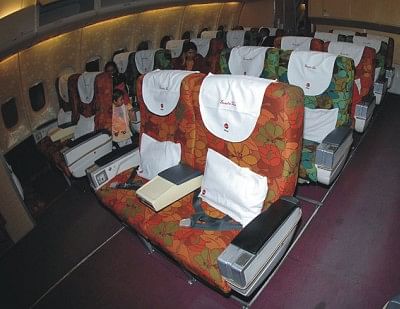Matching slogans with actions

Change must be drastic and quick. Photo: Sam Chui
Congratulations to Biman for its image-building efforts. Given the right conditions and resources, its potential could soon be reached. The new look is a welcome development and an acknowledgement that the airline business is entrenched and heavily tilted in elements that are predominantly marketing more than anything else. Indeed, the air travel industry in general and airline industry in particular are embedded in this reality.
It is nevertheless advisable to tread carefully on unstable ground. It is easy to get carried away with concepts such as branding that are more useful in robust markets with ideal playing conditions, rather than slippery turf that may expose the service or product deficiencies. Changes in livery alone falls far short of full-scale brand identification.
While the new look of Biman catches ones eye, its changes are miniscule in comparison to what it could do to encourage brand loyalty. And that could very well be the catchword loyalty. The slogan "home in the air" is excellent yet it does not reflect Biman's current capabilities, which is a problem. Instead of calling itself a "home in the air," they could say, "we strive for your loyalty" as it seems more appropriate.
There need not be misgivings here. Taglines or slogans, inevitably synonymous with brand packaging, can always be changed. But brand identities, or taglines associated with it, should never "over promise" or "under deliver" on the message conveyed. Either Biman delivers what it promises or it does not. That will be the measure of its performance.
Clearly, the resources that are available to Biman are either grossly under-utilised or limitations are so severe that it greatly hinders performance. The paucity of aircrafts has been the cause of irregularity in schedules, inability to offer increased flights to money spinning markets and such. Maintenance costs incurred abroad make it impossible to register profits even on long haul ethnic markets.
Perhaps the most severe limitation is Biman's inability to utilise its resources. Currently Biman are a band of sound, professionally capable and experienced executives whose services can be best utilised by heeding to their suggestions and ideas. Each of them, having served abroad as Station Heads, are fully abreast of competitive strategies, capable of reinstalling sales, pricing and marketing strategies in both ethnic and non ethnic markets. These employees are far more experienced and capable than one would find in businesses around in the country today.
Yet, each of these experienced employees are on the verge of retirement and the inability to utilise their acumen and expertise stems from the fact that Biman's functionality is not structured on private enterprise. Therefore, developing mission statements, marketing strategies and action plans targeting specific markets are conspicuously absent in this process of re-branding.
The major limiting factor is that while major airlines like Saudia , Singapore Airlines, Emirates or British Airways are blessed with vibrant and reputed hubs, Biman is not. All successful airlines are able to co-brand with their pulsating hubs at home and remote markets and that is the hallmark of their performance. Biman is deprived of this indispensable co-branding that makes airlines successful.
There is nothing demeaning or condescending in accepting that Biman is still a small airline. Small is and can be beautiful. It is prudent to remain within modest taglines reflecting hospitality, warmth and friendliness associated with our culture. These are concepts that Biman can build on until adequate aircraft is inducted and the airline is truly capable of flying on time and reaching out to non-ethnic markets. Take the current crisis that Toyota is facing at this moment. The car manufacturer is unabashedly pulling back its taglines of "safety," "dependability" and "reliability." There's more harm than utility in pretending, worse still, publicising, what one is not.
After the launch of the new look of Biman, it is hoped that the next step will be to develop the product or service commensurate with the mission statement. This will allow a synchronisation of marketing strategies in target markets vis-à-vis advertising strategies and brand packaging. When tag lines resonate with the product or service delivery, true brand loyalty and a robust customer base is sure to follow.

 For all latest news, follow The Daily Star's Google News channel.
For all latest news, follow The Daily Star's Google News channel. 



Comments